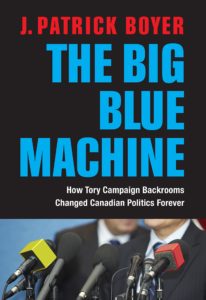The Big Blue Machine: lessons from Canadian politics
 J. Patrick Boyer’s history of the group at the heart of the Canadian Progressive Conservative Party’s campaigning for many years, The Big Blue Machine, is one of those books whose existence is more valuable than a reading of it. That is because it is a long, detailed and comprehensive account of the group around arch-campaigners Dalton Camp and Norman Atkins capturing for posterity much that would otherwise be forgotten and undocumented. But its thoroughness rather drives out analysis or liveliness at times.
J. Patrick Boyer’s history of the group at the heart of the Canadian Progressive Conservative Party’s campaigning for many years, The Big Blue Machine, is one of those books whose existence is more valuable than a reading of it. That is because it is a long, detailed and comprehensive account of the group around arch-campaigners Dalton Camp and Norman Atkins capturing for posterity much that would otherwise be forgotten and undocumented. But its thoroughness rather drives out analysis or liveliness at times.
Boyer is, for example, both detailed yet also unmoved in retelling how the members of the nicknamed Big Blue Machine expected help in running winning election campaigns to convert into public sector contracts awards to the firms of the campaigners after polling day. If you wanted to lay out a charge sheet for outrage, details are all in the book and yet they are presented as neutrally – with not even a defence of such mindsets let alone anger from the author at what many would see as corruption.
Yet there are occasions when a lively account slips in, such as in the healthy warning about how much easier it is for politicians to call for distinctive policy platforms than actually to have them:
When Camp was President of the Progressive Conservative Association of Canada in the 1960s, a dinner discussion with a number of caucus members about party ideology and doctrine led to a conclusion that the PCs simply had to have a clear enunciation of the party’s fundamental principles. Camp excused himself, saying he had a document they might wish to consider. When he returned and handed out copies, the Tory MPs were unanimous in approving the concise statement of support for the monarchy, the rule of law, the primacy of Parliament, the importance of free enterprise as the engine of Canada’s economy, the value of the historic partnership between Canada’s two founding peoples, the dignity of the individual, and respect for civil rights including freedom of speech and freedom of religion.
“Great work, Dalton,” said one, as others nodded in agreement. “That’s exactly nailed it!”
“It’s a direct lift from the constitution of the Liberal Party of Canada,” he replied evenly, looking around the table at the rarely quiet MPs, suddenly silenced.
Such little gems are a little too infrequent, as too is serious analysis of how good – or not – the Big Blue election machine really was. Close analysis of electoral circumstances, political science research and opinion poll data is usually omitted in preference for an older-style narrative history of a group of interesting people. As with the lively anecdotes, the few times when there is real analysis along these lines, giving a rather mixed picture of Big Blue’s efficacy, leaves an inquisitive reader wanting more.
The answer, by the way, to the book’s subtitle, “How Tory Campaign Backrooms Changed Canadian Politics Forever” is ‘by copying existing ideas from marketing, advertising and other countries’ – a handy reminder for people in politics in all countries about how often that simple formula for inspiration works.
If you like this, you might also be interested in Hacking the electorate.
Leave a Reply